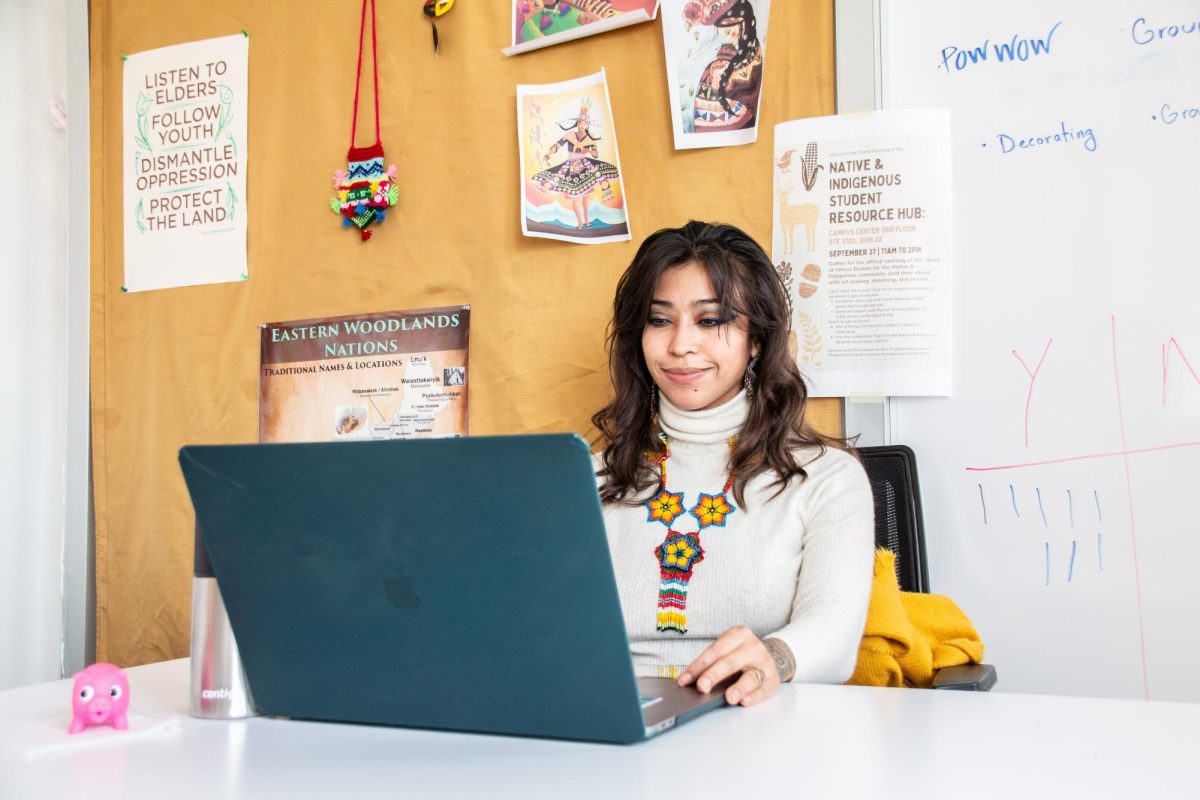On Oct. 4, UMass Boston announced that a new student center had opened on campus under the student center and organization space in the third floor of the Campus Center, Room 3100. The Native & Indigenous Student Resource Hub was officially celebrated and formed in the last week of September, and aims to serve as a home and resource space for Native and Indigenous students throughout the UMass Boston community. In a statement from Assistant Professor of Native American History Maria John to UMass Boston News:
“‘I don’t think we can underestimate the power of having a place that is just for the students,’ John said. ‘This brings visibility, community, the opportunity to build, a sense of belonging, and so much more.’” [1]
These ideas seemed to be a core focus of the newly formed space, with several students—as well as the group’s advisor—sharing the same sentiments. Valentina Romero and Jacqueline Campo, two students involved in the hub and its early stages of creation, were willing to sit down and discuss what having such a resource meant to them, as well as what the future of the space could look like.
“A lot of the idea, or the main idea of this hub is to have a space on campus for Native American and Indigenous students to feel like they have a space where they belong, a space where they can hang out and build community, a space where events will be happening,” said Romero. “Just having the physical space to foster community—we like to think about it as like our own campus kind of living room in that sense.”
Following up on what Romero said, Campo added, “There is a room in the university for a lot of groups where students feel they identify with, and when we talk about Native and Indigenous people, and we’re trying to find this space, […] I’m so happy that it is now physical. But even if it wasn’t physical, like digital, like what kind of space that you can bond with people that has this sharing, this collectiveness, this identity. I have been looking for that for a while.”
However, things have not been smooth sailing in creating the new space. According to the advisor for the space, Jamie Morrison, who also works for the Institute for New England Native American Studies, the creation of the Native student program has seen several instances of starts and stops over the past few years. Despite these setbacks, Morrison remains optimistic.
“I would love to really be able to have the students establish themselves as a community on campus—a recognized community on campus—that’s doing programming, having events and sharing what we have to offer with the rest of the university community,” said Morrison. “And internally, I want the students to know that this is a place that they’re comfortable (in) and that they have the freedom to express themselves and be as creative as they want to be, to take initiatives and put them in leadership positions.”
Throughout the two conversations, a core theme of visibility continued to shine through. Many centers at UMass Boston, such as the Queer Student Center, Casa Latina, the Asian Student Center or the Black Student Center, allow their members a chance at not only involvement and activism, but visibility; a chance to put faces to identities. With the formation of the Native & Indigenous Student Resource Hub, this will be a similar sentiment for Native and Indigenous students, as well as their history.
“I think visibility is also important. I very much want to stress the fact that indigenous people and indigenous students are very much in the present, and we’re still here. We are on indigenous land. And there’s a process of land acknowledgment that hopefully will take off to give us a little bit more visibility of the history of the places that we inhabit,” said Romero.
Campo further amplified these statements by saying, “Every time you talk about ‘indigenous,’ the narrative is like ‘they were,’ ‘they was’—like a specific language. It’s in the past. But we’re not in the past; we’re in 2023, here in higher education. And we don’t have to have to be in some way to be recognized as such. I feel like that idea is really important, like, we’re here, we’re in the present.”
For students looking to get involved with the Native and Indigenous Student Hub, Romero and Campo discussed plans for events that will allow students to engage and learn with the Native and Indigenous population and resources, such as an event that was held on Oct. 18 in partnership with Native American Lifeline. This event offered students a chance to grab a slice of pizza or a snack and talk with the people from Native American Lifeline, as well as get to know their resources. Likewise, the grand opening for the hub offered students a chance to eat some snacks, make art and learn about resources, as explained by the press release on the UMass Boston website. [1]
Those looking to get involved, or just looking to stop by, can visit the Native & Indigenous Student Resource Hub on the third floor of the Campus Center, in Room 3100, suite 3006.02.
[1] Bilotta, D. (2023, Oct. 4). Campus Celebrates Native & Indigenous Student Resource Hub Grand Opening. https://www.umb.edu/news/recent-news/native–indigenous-student-resource-hub/





















































